Behind the scenes: Shaq, Kobe, Karl Malone, Gary Payton era; Marbury, Larry Brown, Lin, Melo
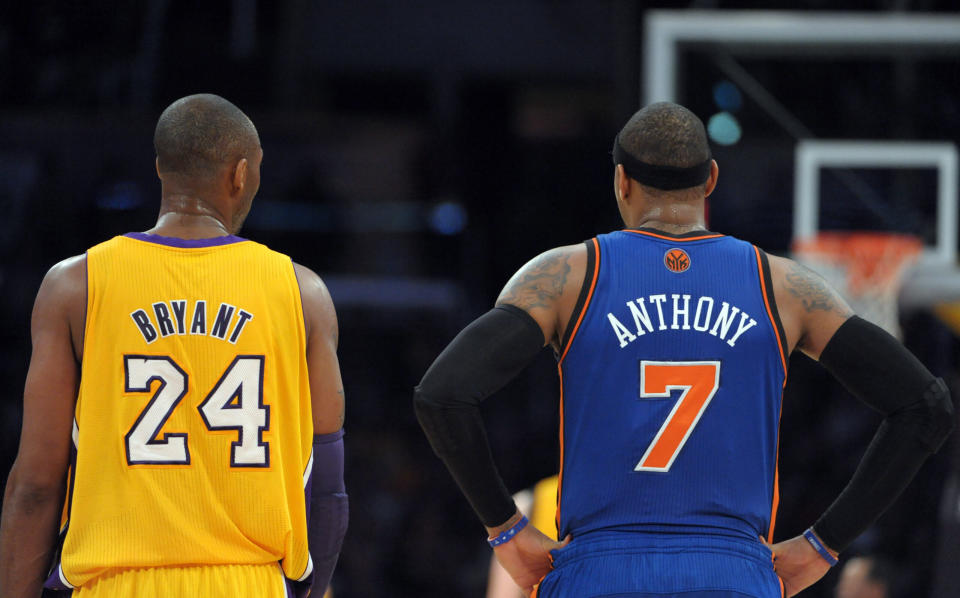
HoopsHype’s Michael Scotto and Sports Illustrated’s Howard Beck discuss behind the scenes stories about Shaquille O’Neal and Kobe Bryant’s relationship, how Karl Malone tried to play peacemaker, Gary Payton’s gripe with the Triangle offense, and more. Beck also discussed how the power struggles between Larry Brown, Stephon Marbury and Isiah Thomas, along with Carmelo Anthony, Jeremy Lin, Amare Stoudemire and Mike D’Antoni unfolded behind the scenes on the latest HoopsHype podcast episode.
For more interviews with players, coaches, and media members, be sure to like and subscribe to the HoopsHype podcast on Spotify, Apple Podcasts, and anywhere else you listen to podcasts. Listen to the podcast above or check out some snippets of the conversation in a transcribed version below.
2:00 Los Angeles Lakers stars who struggled
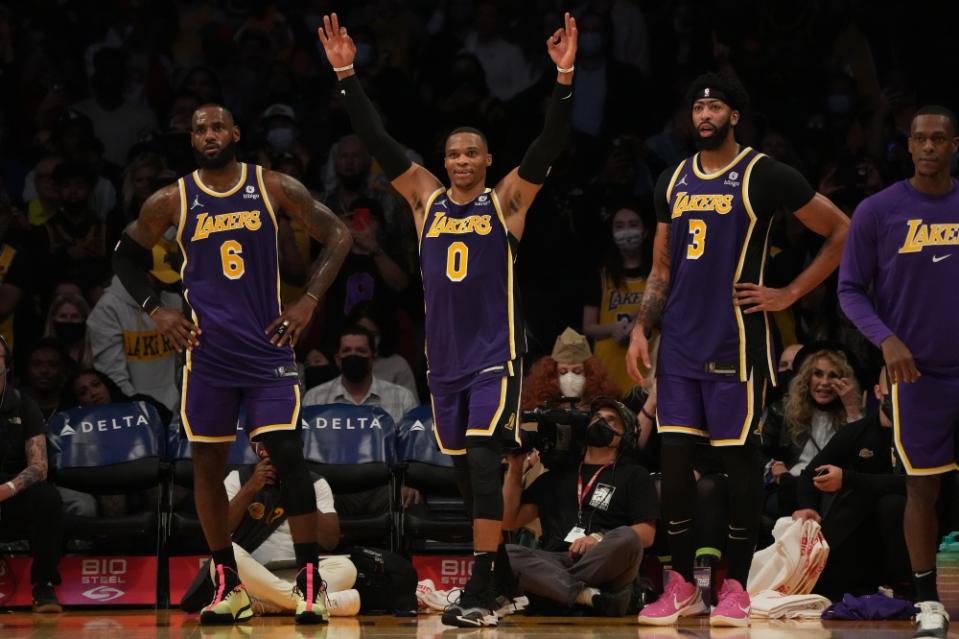
Kirby Lee-USA TODAY Sports
Scotto: Once again, the Lakers are loaded with stars in Russell Westbrook, Anthony Davis, and LeBron James… I don’t know if we’ve seen the Lakers struggle with these types of stars since Kobe Bryant and Pau Gasol were teamed with Dwight Howard and Steve Nash.
Beck: The Lakers as a franchise that’s about stars. In NBA history, stars drive the league and championships. The Lakers are the epitome of this model, and they have this knack and are a magnet for superstar talent. More often than not, it goes pretty well… I think there’s a danger there, and what we’re seeing this season is the danger where you over-index on the stars and think stars are the only way forward, and it doesn’t matter which stars, how they fit, whether they fit, or what stage of their career they’re at.
To your analogy, the last time they struggled by over-indexing on stars and overindulging like we do at Thanksgiving, where you could’ve just stopped after the third helping of turkey, and you decide to go for the fourth round, that’s Westbrook now. That was adding Howard and Nash to Kobe and Pau at the time.
People often look back also to the 2003-04 season when they got Karl Malone and Gary Payton to go with Shaq and Kobe. That team went to the Finals. I don’t know why I have to remind folks of this periodically. That team, which was supposedly an example of having too many stars and failing under its own weight, went to the Finals.
Scotto: As for your Westbrook analogy about Thanksgiving and the fourth helping of turkey, I looked at Westbrook and the Lakers at this point, and when you think of a star guard who began to taper off into his 30s, the guy that sticks out to me was Allen Iverson towards the end with the Grizzlies (comparatively).
6:30 Sports Illustrated’s new book, The Greatest Show on Earth: A History of the Los Angeles Lakers' Winning Tradition
Beck: I didn’t write or edit the book. I had the honor of writing the foreword for the book, and one of my SI pieces about Kobe is the last chapter of the book… This is a who’s who of the best writers writing about the who’s who of all the greatest Lakers. It’s from SI and Triumph Books collaborating. If you love the Lakers and NBA history, I think it’s great. If you love great sports writing, there are pieces by Frank DeFord, Jack McCallum, Phil Taylor, Chris Ballard, Lee Jenkins, and all the great Lakers. It’s Elgin Baylor, Jerry West, Wilt Chamberlain, Kareem Abdul-Jabbar, Magic Johnson, Shaq, Kobe, and LeBron.
I have a promo code if you order through the Triumph Books website. Go to triumphbooks.com and do a search on “The Greatest Show on Earth” and find the book. If you enter Lakers30, there’s a 30 percent discount for the purchase only through that website.
14:00 Shaq and Kobe interacting with the media behind the scenes
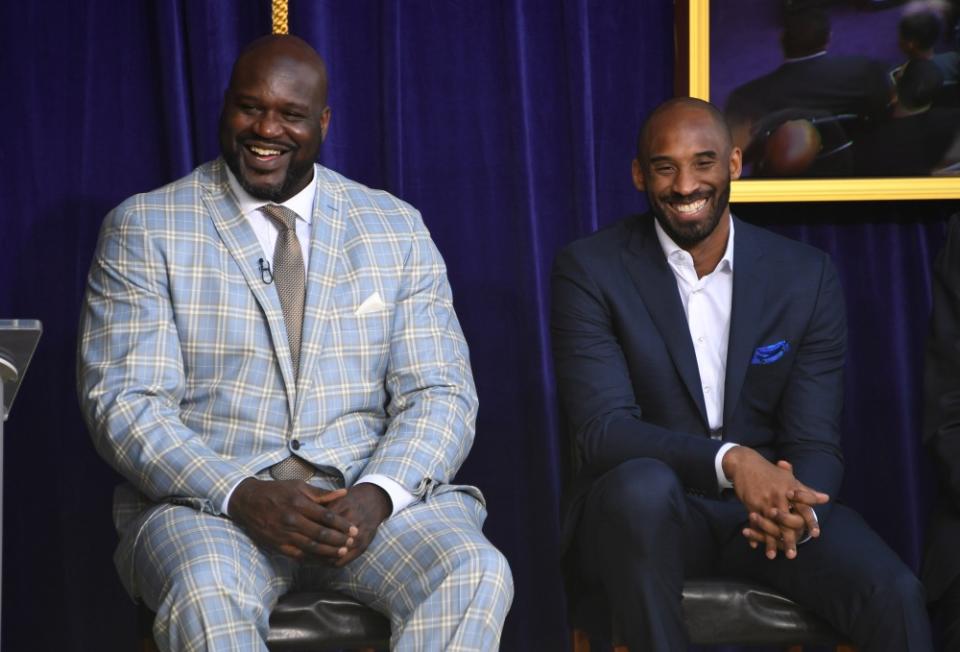
Kirby Lee-USA TODAY Sports
Beck: There was tension between them at any given year from 1997-2004 when I covered them… During those seven years, there were moments that were really light with both of those guys, and then there were moments of extreme tension. The fact is, as everybody knows, Shaq is just a big overgrown kid. To this day, even in his role at TNT, you still see it. I mean that in the most endearing way possible. He loves to be the life of the party and practical jokes.
Behind the scenes, I think of moments with Shaq and us (media) where things would get mockingly contentious sometimes. He’d get a little snippy about what we’d ask him about or snippy because that he wouldn’t win MVP one year, and he said, “You guys have already given it away.” It was the year Jason Kidd was reviving the Nets, and he thought Kidd would win it. By midseason, that was all the buzz, but I think Tim Duncan won it that year.
Tim Kawakami was a beat writer a couple of those years for the L.A. Times. He was pretty aggressive and had a way of getting under Shaq’s skin sometimes. Shaq would tell him, “Ask me a good question.” One day, Kawakami asked him a question in the Lakers’ locker room, and Shaq looked up, smiled and said, “Kawakami asked a good question.” He leaped up and grabbed him, and started pogo sticking him around the locker room. Imagine a person being completely enveloped by this 7-foot mammoth of a human being, almost disappearing into Shaq as he’s hopping up and down. Kawakami was holding on for dear life.
My version of that was a couple of years later. We were in Dallas at the American Airlines Center in Dallas. I asked something Shaq objected to, and rather than curse me out or walk away at shootaround, Shaq leaned over, grabbed me, and threw me over his shoulder like a sack of potatoes. I’m over his shoulder, looking down his backside with my notepad in one hand and my recorder in the other hand, holding on for dear life and trying not to drop my stuff, wondering how this is going to end.
Kobe was the quieter of the two overall. He was great one-on-one… We were in Memphis one day pregame, and Kobe had a commercial where he leaps from halfcourt to dunk, and we chatted about it. He explained the process behind it. He was fun to talk to. It was never as harrowing as some of the things with Shaq. He wasn’t the jokester that Shaq was.
23:00 Tensions between Kobe and Shaq

Nathaniel S. Butler/NBAE via Getty Images
Beck: It wasn’t the kind of thing where they were sniping in front of us. It’s a tension you felt that came out in other ways. Shaq had this way of using vaguely coded language when he was pissed about Kobe’s actions on the court. Postgame, Shaq would say things like, “Guys were out there taking ill-advised shots.” He might have meant everybody who’s a jump shooter who’s not him who could just power through guys. At one point, that was about Eddie Jones, Kobe, and even Nick Van Exel. It was basically, “Get me the damn ball.” His basic message was I’m the baddest mfer out there, and I’m going to dunk on everyone. I’m the highest percentage option we have.
One year he made a reference that guys were taking a one-legged Rex Chapman shot. That was often a shot at Kobe. He’d use other phrases like “I’ve never been a jump shooter, but all I know is shots aren’t falling. Gotta mix it up and take it to the rack.” Those were these passive aggressive shots at Kobe, and Kobe never did it in reverse.
Kobe famously, I think it was in their final season, had that statement that he issued through Jim Gray – which was always very strange because we never heard Kobe say it, and it wasn’t on camera or anything. Gray had a statement from Kobe that was three or four paragraphs long, and it was an unmitigated slaughter calling out Shaq on everything. It was like he saved this up for years. It was about Shaq delaying his toe surgery and burning part of the season to recover from it. Shaq not being in shape. Kobe considered himself much more committed to the game. Kobe lived and breathed it and was obsessive about it. Shaq wasn’t. That was the big difference between them more than anything else. They were just wired differently. It just underlies all the other tension about shots, control of the offense and other stuff.
There were other times where they tried to diffuse things. In the pregame locker room one day at Staples Center, Kobe just had a Sprite commercial come out where he imagines himself in all these other jobs if he didn’t play basketball… Shaq comes in the locker room and starts making fun of him. They start making fun of each other’s commercials. There was one where Shaq is in a commercial where the dog comes and steals something out of his hand, and the dog’s named Brick. Shaq is yelling “Brick” to the dog to bring the thing back, and Kobe and Shaq made fun of each other. It was like, are they really goofing on each other in a genuine way? Or is this them putting on a little bit of a show in front of the media to downplay the tension at the time?
28:00 Karl Malone and Gary Payton Lakers season
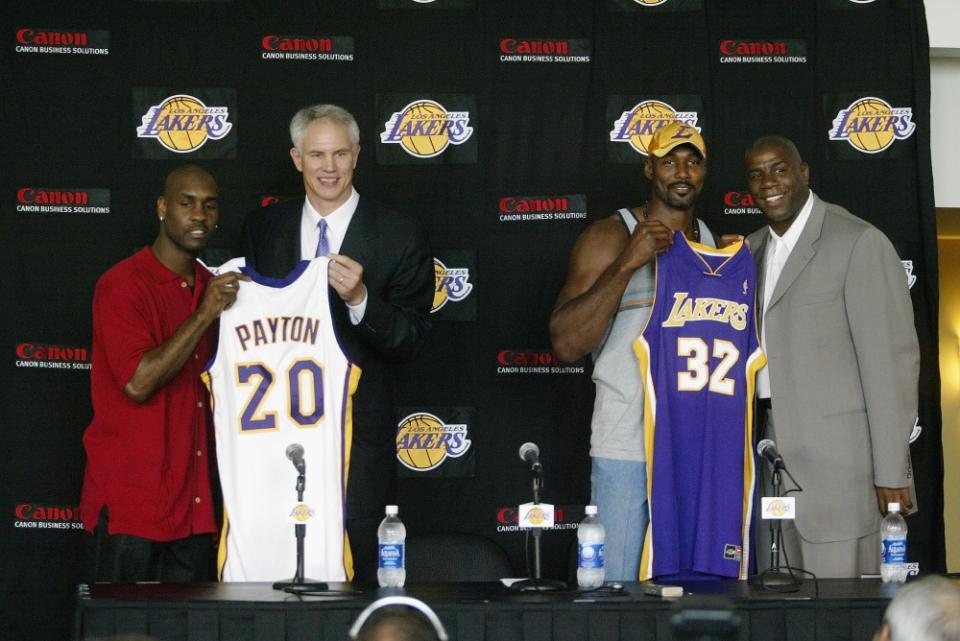
Stephen Dunn-Getty Images
Scotto: They went to the Finals that year and lost. The way it was made out to be was a failure because they were such favorites on paper. For Malone, it would’ve represented that missing championship that he ultimately never got… What stuck out to you about that season and the dynamic with Shaq, Kobe, Malone, and Payton?
Beck: If you wanted to find out the bottoming point of their relationship, that was almost literally it. Shaq was traded a few weeks after that Finals ended. They (Shaq and Kobe) were just done with each other. Shaq in that series wasn’t at his absolute peak at that point, but his field goal percentage in that series was .631. He was still kicking people’s butt when he got the ball, but he wasn’t getting it enough. Kobe was calling his own shots all the time in that series. He shot his worst field goal percentage. Kobe shot 38 percent in that series. I think it was his worst postseason series to date in his career at that point.
Karl Malone was hurt. Everybody ignores this part of it. He only played in four of the five games. He averaged 31 minutes in that series. He missed a lot of the regular season because of a freak accident where Scott Williams fell into him and hurt his knee. Malone was the guy holding Shaq and Kobe and holding the team together and keeping Shaq and Kobe from beating the heck out of each other early that season.
Gary Payton didn’t want to play in the Triangle. He hated the Triangle, but he signed there to play for Phil Jackson, and he should’ve known. If there was one player who didn’t fit, it was Payton. He didn’t fit the Triangle and rebelled against it in a way.
33:00 Behind the scenes of the Larry Brown and Stephon Marbury feud
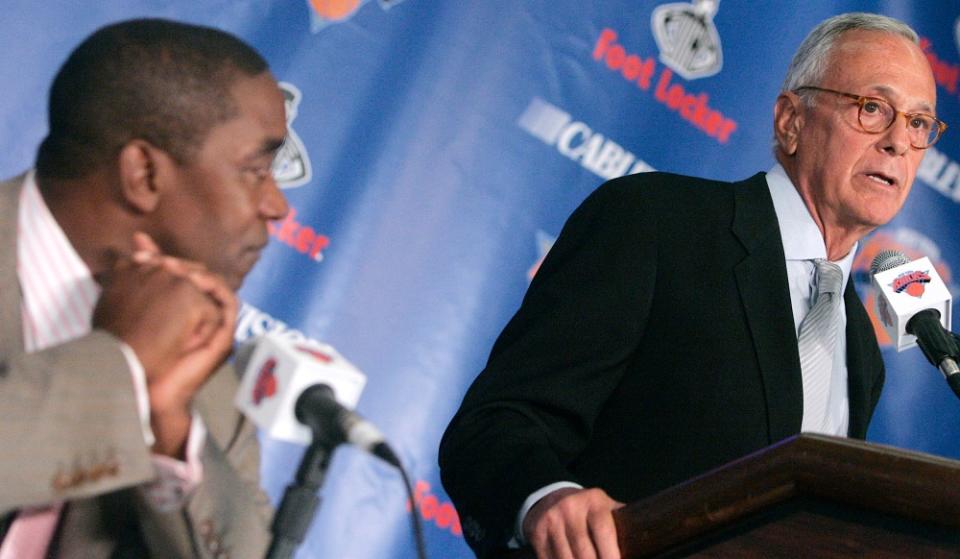
Stephen Chernin-Getty Images
Scotto: I had Eddy Curry on the podcast. He had some fun stories about the two of those guys going at it during the season and being neighbors with essentially backyards attached to each other. Being around those guys every day, they went at it.
Beck: There was just so much mayhem. The conflict wasn’t just Larry Brown and Stephon Marbury. They eventually made a trade for Steve Francis. Brown thought he was going to play Francis off of Marbury, but Marbury and Francis ended up bonding and uniting against Brown. Meanwhile, Isiah Thomas is having issues with Brown and issues with Marbury. At any given time, it was either Larry versus Isiah, Larry versus Marbury, or Marbury versus Isiah. It was utter mayhem.
Brown got fired after one year, and the owner told Isiah this was basically your groceries, and now you had to make the dinner. It’s your roster, and you’re saying it’s Brown’s fault, so go fix it and coach. There was just so much drama, tumult, turnover, and politicking.
Marbury would say things about Brown, who’d say things about Marbury. There was a day when Brown said something at postgame the night before. Shootaround Marbury fires back. Pregame, Brown fires back. It was constantly us going from one to the other saying, “Hey, I hate to ask you this, but the other guy just said this.”
It drove the Garden crazy because they have a rule that goes back to previous eras where no one from the Knicks organization or the Garden is supposed to say anything disparaging about anybody else in public. This was an actual policy that was on the books. It drove them crazy more than anything, more than the losing.
37:00 Carmelo Anthony, Amare Stoudemire and Jeremy Lin behind the scenes

Matthew Emmons-USA TODAY Sports
Beck: Amare (Stoudemire) loved playing with Jeremy (Lin) in part because Amare was a disciple of Mike D’Antoni. The seven seconds or less offense that Steve Nash famously brought to life in Phoenix made them one of the most entertaining teams in the NBA. When Amare came to New York to play for D’Antoni, he’s all on board with what D’Antoni’s about philosophically and the ball “finding energy,” as D’Antoni would say. Amare loved that Linsanity run. Carmelo (Anthony) did not exactly like Mike’s offense. That relationship eroded so badly that D’Antoni officially re-signed, whether people want to say he was pushed, shoved, or asked. When D’Antoni resigned, and it turned over to Mike Woodson, it was almost entirely because his relationship with Carmelo was nonexistent because Mike wanted the ball to move, and Carmelo wanted to do what he does, which is a lot of isolation.
I think, and it’s been written about in the past, but Carmelo – there was a little bit of resentment there. Lin was the toast not just of New York but of the whole basketball world. He was on magazine covers around the globe for this magical run. Carmelo was the guy who came home as the conquering hero, and they played the “Coming Home” song when he made his debut. When Lin got the poison pill contract offer from the Rockets as a restricted free agent, which the Knicks chose not to match, Carmelo went on record referring to the contract as that crazy contract or something along those lines. Players never say that about each other’s contract. Carmelo disparaged the contract.
Amare and Carmelo never really saw eye to eye. Amare wanted to do things the D’Antoni way. Carmelo wanted to do things that benefited his game the most.
46:00 Advice for aspiring young NBA writers
Beck: Nothing can replace curiosity. That’s the key to all good journalism, reporting, and storytelling. Then, following that curiosity up by asking questions. Some people get into it because they want to write about basketball. I think some people think the idea is to be a basketball expert. That’s fine. That’s a model to write about the NBA. I’ve always taken the approach that I’m not an expert on basketball. My job is to talk to the experts. That’s what journalism is.
You can follow Michael Scotto (@MikeAScotto) and Howard Beck (@HowardBeck) on Twitter.
[listicle id=1772699]
[listicle id=1590727]
[listicle id=1772145]

